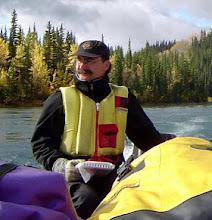I grew up in 1950s Winnipeg. It was then also a city of human migrants, the earliest as economic refugees from the harsh North Atlantic fringe - industrializing England, starving Iceland, Scotland and Scandinavia, later ones as refugees of the twentieth century European wars - Poles, Italians, Greeks and especially Germans in large number. My family arrived in southern Manitoba in the late 1920s, escapees from the chaos and violence of the Russian Revolution. And all of these groups hung together, retaining language, foods, faiths and social coherence.
Winnipeg was a melting pot at room temperature, chunky, indisolveable lumps bumping into each other, all aspiring to fit in, secretly wanting to become English speaking Canadians without losing themselves. And through the 1960s, my generation learned English, our faiths fit in, German was taught on Saturday mornings (and required for Christmas carols and wedding celebrations), food moved from Oma's kitchen to restaurants in the Northend (One on Pembina Highway is called Oma's Kitchen) and the tight bonds of social coherence loosened under the warm sun of multi-culturalism.When I left Winnipeg in the early 1970s I was a Canadian.
On this trip my Dad and I made a Sunday afternoon trip to City Park. We visited the English Garden, long a centre piece of the park, and sat down on one of the benches circling the garden fountain. It was a busy place.
 |
| My Dad was two when my Oma and Opa escaped the chaos of post-revolutionary Russia in 1926. |
On the bench next to us a young and beaming Iranian couple proudly celebrated the obviously recent arrival of their infant son. An aged terrier sat stiffly alert beside them as its very English mistress cooed to the baby and smiled warm thoughts to the parents. The intimacy of this exchange was trumped by the arrival of the lively Japanese wedding party. The bride, wearing a tight fitting red Uchikake (the traditional bridal outfit donned for the post-ceremony reception) and impossibly high heeled shoes, giggled as her smiling husband trotted obediently alongside. A group of tiny aunties and large, jovial uncles boisterously ordered the couple, here, then there, for the perfect photo.Where were all the young photographers now? The bride charmed the little boy with her bouquet, a tight arrangement of small blossoms with Miss Kitty grinning benignly outwards.On our way out we met a family, Mother and Father in Sunday black with two teen daughters with long dark hair. They were earnestly engaged in conversation, speaking Serbo-Croatian, probably not wishing they were English but probably also understanding that they were Canadian.
We went to Dawnings for supper. It is the best Mennonite food restaurant in the Westend. As always I order the Verenki and Baurenwurst (perogies and farmer sausage), delicious with sauce just the way I remember my Oma making. The family who runs it is Phillipino.
The idea of the unitary nation state has migrated into the past, Canada is a pluralist country that seems to be working well this Sunday.






No comments:
Post a Comment